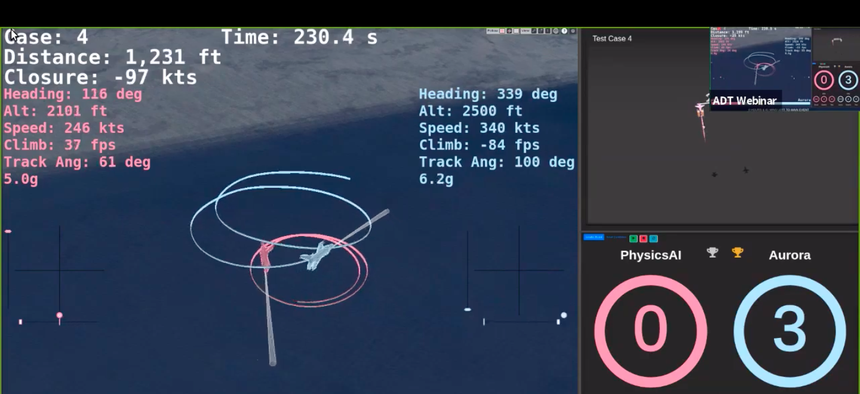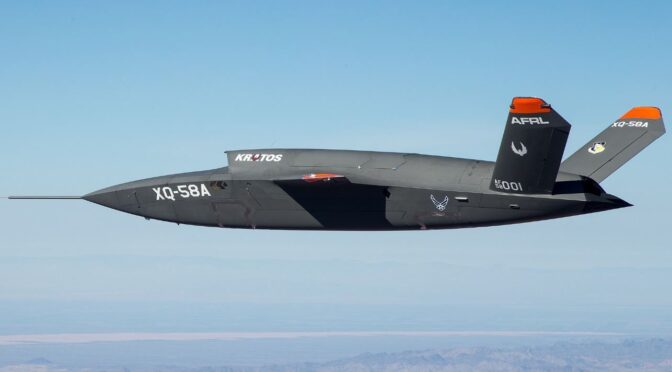By Trevor Phillips-Levine, Dylan Phillips-Levine, and Walker D. Mills
In August 2020, USNI News reported that the Navy had “initiated work to develop its first new carrier-based fighter in almost 20 years.” While the F-35C Lightning II will still be in production for many years, the Navy needs to have another fighter ready to replace the bulk of the F/A-18E/F/G Super Hornets and Growlers by the mid-2030s. This new program will design that aircraft. While this is an important development, it will be to the Navy’s detriment if the Next Generation Air Dominance (NGAD) program yields a manned fighter.
Designing a next-generation manned aircraft will be a critical mistake. Every year remotely piloted aircraft (RPAs) replace more and more manned aviation platforms, and artificial intelligence (AI) is becoming ever increasingly capable. By the mid-2030s, when the NGAD platform is expected to begin production, it will be obsolete on arrival if it is a manned platform. In order to make sure the Navy maintains a qualitative and technical edge in aviation, it needs to invest in an unmanned-capable aircraft today. Recent advances and long-term trends in automation and computing make it clear that such an investment is not only prudent but necessary to maintain capability overmatch and avoid falling behind.
Artificial Intelligence
This year, AI designed by a team from Heron Systems defeated an Air Force pilot, call sign “Banger,” 5-0 in a simulated dogfight run by DARPA. Though the dogfight was simulated and had numerous constraints, it was only the latest in a long string of AI successes in competitions against human masters and experts.
Since 1997, when IBM’s DeepBlue beat the reigning world chess champion Gary Kasparov over six games in Philadelphia, machines have been on a winning streak against humans. In 2011, IBM’s “Watson” won Jeopardy!. In 2017, DeepMind’s (Google) “AlphaGo” beat the world’s number one Go player at the complex Chinese board game. In 2019, DeepMind’s “AlphaStar” beat one of the world’s top-ranked Starcraft II players, a real-time computer strategy game, 5-0. Later that year an AI from Carnegie Mellon named “Pluribus” beat six professionals in a game of Texas Hold’em poker. On the lighter side, an AI writing algorithm nearly beat the writing team for the game Cards Against Humanity in a competition to see who could sell more card packs in a Black Friday write-off. After the contest the company’s statement read: “The writers sold 2% more packs, so their jobs will be replaced by automation later instead of right now. Happy Holidays.”
It’s a joke, but the company is right. AI is getting better and better every year and human abilities will continue to be bested by AI in increasingly complex and abstract tasks. History shows that human experts have been repeatedly surprised by AI’s rapid progress and their predictions on when AI will reach human parity in specific tasks often come true years or a decade early. We can’t make the same mistake with unmanned aviation.

Most of these competitive AIs use machine learning. A subset of machine learning is deep reinforcement learning which uses biologically inspired evolutionary techniques to pit a model against itself over and over. Models that that are more successful at accomplishing the specific goal – such as winning at Go or identifying pictures of tigers, continue on. It is like a giant bracket, except that the AI can compete against itself millions or even billions of times in preparation to compete against a human. Heron Systems’ AI, which defeated the human pilot, had run over four billion simulations before the contest. The creators called it “putting a baby in the cockpit.” The AI was given almost no instructions on how to fly, so even basic practices like not crashing into the ground were things it had to learn through trial and error.
This type of ‘training’ has advantages – algorithms can come up with moves that humans have never thought of, or use maneuvers humans would not choose to utilize. In the Go matches between Lee SeDol and AlphaGo, the AI made a move on turn 37, in game two, that shocked the audience and SeDol. Fan Hui, a three-time European Go champion and spectator of the match said, “It’s not a human move. I’ve never seen a human play this move.” It is possible that the move had never been played before in the history of the game. In the AlphaDogfight competition, the AI favored aggressive head-on gun attacks. This tactic is considered high-risk and prohibited in training. Most pilots wouldn’t attempt it in combat. But an AI could. AI algorithms can develop and employ maneuvers that human pilots wouldn’t think of or wouldn’t attempt. They can be especially unpredictable in combat against humans because they aren’t human.

An AI also offers significant advantages over humans in piloting an aircraft because it is not limited by biology. An AI can make decisions in fractions of a second and simultaneously receive input from any number of sensors. It never has to move its eyes or turn its head to get a better look. In high-speed combat where margins are measured in seconds or less, this speed matters. An AI also never gets tired – it is immune to the human factors of being a pilot. It is impervious to emotion, mental stress, and arguably the most critical inhibitor, the biological stresses of high-G maneuvers. Human pilots have a limit to their continuous high-G maneuver endurance. In the AlphaDogfight, both the AI and “Banger,” the human pilot, spent several minutes in continuous high-G maneuvers. While high G-maneuvers would be fine for an AI, real combat would likely induce loss of consciousness or G-LOC for human pilots.
Design and Mission Profiles
Aircraft, apart from remotely piloted aircraft (RPAs), are designed with a human pilot in mind. It is inherent to the platform that it will have to carry a human pilot and devote space and systems to all the necessary life support functions. Many of the maximum tolerances the aircraft can withstand are bottlenecked not by the aircraft itself, but to its pilot. An unmanned aircraft do not have to worry about protecting a human pilot or carrying one. It can be designed solely for the mission.
Aviation missions are also limited to the endurance of human pilots, where there is a finite number of hours a human can remain combat effective in a cockpit. Using unmanned aircraft changes that equation so that the limit is the capabilities of the aircraft and systems itself. Like surveillance drones, AI-piloted aircraft could remain on station for much longer than human piloted aircraft and (with air-to-air refueling) possibly for days.
The future operating environment will be less and less forgiving for human pilots. Decisions will be made at computational speed which outpaces a human OODA loop. Missiles will fly at hypersonic speeds and directed energy weapons will strike targets at the speed of light. Lockheed Martin has set a goal for mounting lasers on fighter jets by 2025. Autonomous aircraft piloted by AI will have distinct advantages in the future operating environment because of the quickness of its ability to react and the indefinite sustainment of that reaction speed. The Navy designed the Phalanx system to be autonomous in the 1970s and embedded doctrine statements into the Aegis combat system because it did not believe that humans could react fast enough in the missile age threat environment. The future will be even more unforgiving with a hypersonic threat environment and decisions made at the speed of AI that will often trump those made at human speeds in combat.
Unmanned aircraft are also inherently more “risk worthy” than manned aircraft. Commanders with unmanned aircraft can take greater risks and plan more aggressive missions that would have featured an unacceptably low probability of return for manned missions. This increased flexibility will be essential in rolling back and dismantling modern air defenses and anti-access, area-denial networks.
Unmanned is Already Here
The U.S. military already flies hundreds of large RPAs like the MQ-9 Predator and thousands of smaller RPAs like the RQ-11 Raven. It uses these aircraft for reconnaissance, surveillance, targeting, and strike. The Marine Corps has flown unmanned cargo helicopters in Afghanistan and other cargo-carrying RPAs and autonomous aircraft have proliferated in the private sector. These aircraft have been displacing human pilots in the cockpit for decades with human pilots now operating from the ground. The dramatic proliferation of unmanned aircraft over the last two decades has touched every major military and conflict zone. Even terrorists and non-state actors are leveraging unmanned aircraft for both surveillance and strike.
Apart from NGAD, the Navy is going full speed ahead on unmanned and autonomous vehicles. Last year it awarded a $330 million dollar contract for a medium-sized autonomous vessel. In early 2021, the Navy plans to run a large Fleet Battle Problem exercise centered on unmanned vessels. The Navy has also begun to supplement its MH-60S squadrons with the unmanned MQ-8B. Chief among its advantages over the manned helicopter is the long on-station time. The Navy continues to invest in its unmanned MQ-4C maritime surveillance drones and has now flight-tested the unmanned MQ-25 Stingray aerial tanker. In fact, the Navy has so aggressively pursued unmanned and autonomous vehicles that Congress has tried to slow down its speed of adoption and restrict some funding.
The Air Force too has been investing in unmanned combat aircraft. The unmanned “loyal wingman” drone is already being tested and in 2019 the service released its Artificial Intelligence Strategy arguing that “AI is a capability that will underpin our ability to compete, deter and win.” The service is also moving forward with testing their “Golden Horde,” an initiative to create a lethal swarm of autonomous drones.
https://gfycat.com/sentimentalunknownharpyeagle
The XQ-58A Valkyrie demonstrator, a long-range, high subsonic unmanned air vehicle completed its inaugural flight March 5, 2019 at Yuma Proving Grounds, Arizona. (U.S. Air Force video)
The Marine Corps has also decided to bet heavily on an unmanned future. In the recently released Force Design 2030 Report, the Commandant of the Marine Corps calls for doubling the Corps’ unmanned squadrons. Marines are also designing unmanned ground vehicles that will be central to their new operating concept, Expeditionary Advanced Base Operations (EABO) and new, large unmanned aircraft. Department of the Navy leaders have said that they would not be surprised if as much as 50 percent of Marine Corps aviation is unmanned “relatively soon.” The Marine Corps is also investing in a new “family of systems” to meet its requirement for ship-launched drones. With so much investment in other unmanned and autonomous platforms, why is the Navy not moving forward on an unmanned NGAD?
Criticism
An autonomous, next-generation combat aircraft for the Navy faces several criticisms. Some concerns are valid while others are not. Critics can rightly point out that AI is not ready yet. While this is certainly true, it likely will be ready enough by the mid-2030s when the NGAD is reaching production. 15 years ago, engineers were proud of building a computer that could beat Gary Kasparov at chess. Today, AIs have mastered ever more complex real-time games and aerial dogfighting. One can only expect AI will make a similar if not greater leap in the next 15 years. We need to be future-proofing future combat aircraft. So the question should not be, “Is AI ready now?” but, “Will AI be ready in 15 years when NGAD is entering production?”
Critics of lethal autonomy should note that it is already here. Loitering munitions are only the most recent manifestation of weapons without “a human in the loop.” The U.S. military has employed autonomous weapons ever since Phalanx was deployed on ships in the 1970s, and more recently with anti-ship missiles featuring intelligent seeker heads. The Navy is also simultaneously investing in autonomous surface vessels and unmanned helicopters, proving that there is room for lethal autonomy in naval aviation.
Some have raised concerns that autonomous aircraft can be hacked and RPAs can have their command and control links broken, jammed, or hijacked. But these concerns are no more valid with unmanned aircraft than manned aircraft. Modern 5th generation aircraft are full of computers, networked systems, and use fly-by-wire controls. A hacked F-35 will be hardly different than a hacked unmanned aircraft, except there is a human trapped aboard. In the case of RPAs, they have “lost link” protocols that can return them safely to base if they lose contact with a ground station.
Unfortunately, perhaps the largest obstacle to an unmanned NGAD is imagination. Simply put, it is difficult for Navy leaders, often pilots themselves, to imagine a computer doing a job that they have spent years mastering. They often consider it as much an art as a science. But these arguments sound eerily similar to arguments made by mounted cavalry commanders in the lead up to the Second World War. As late as 1939, Army General John K. Kerr argued that tanks could not replace horses on the battlefield. He wrote: “We must not be misled to our own detriment to assume that the untried machine can displace the proved and tried horse.” Similarly, the U.S. Navy was slow to adopt and trust search radars in the Second World War. Of their experience in Guadalcanal, historian James D. Hornfischer wrote, “…The unfamiliar power of a new technology was seldom a match for a complacent human mind bent on ignoring it.” Today we cannot make the same mistakes.
Conclusion
The future of aviation is unmanned aircraft – whether remotely piloted, autonomously piloted, or a combination. There is simply no reason that a human needs to be in the cockpit of a modern, let alone next-generation aircraft. AI technology is progressing rapidly and consistently ahead of estimates. If the Navy waits to integrate AI into combat aircraft until it is mature, it will put naval aviation a decade or more behind.
Platforms being designed now need to be engineered to incorporate AI and future advances. Human pilots will not be able to compete with mature AI – already pilots are losing to AI in dogfights; arguably the most complex part of their skillset. The Navy needs to design the next generation of combat aircraft for unmanned flight or it risks making naval aviation irrelevant in the future aerial fight.
Trevor Phillips-Levine is a lieutenant commander in the United States Navy. He has flown the F/A-18 “Super Hornet” in support of operations New Dawn and Enduring Freedom and is currently serving as a department head in VFA-2. He can been reached on Twitter @TPLevine85.
Dylan Phillips-Levine is a lieutenant commander in the United States Navy. He has flown the T-6B “Texan II” as an instructor and the MH-60R “Seahawk.” He is currently serving as an instructor in the T-34C-1 “Turbo-Mentor” as an exchange instructor pilot with the Argentine navy. He can be reached on Twitter @JooseBoludo.
Walker D. Mills is a captain in the Marines. An infantry officer, he is currently serving as an exchange instructor at the Colombian naval academy. He is an Associate Editor at CIMSEC and an MA student at the Center for Homeland Defense and Security at the Naval Postgraduate School. You can find him on twitter @WDMills1992.
Featured Image: The XQ-58A Valkyrie demonstrator, a long-range, high subsonic unmanned air vehicle completed its inaugural flight March 5, 2019 at Yuma Proving Grounds, Arizona. (DoD)


Fantastic article and very useful
Dylan…
Its Pirates_Smile…HMU on the phone. I need to discuss something aviation-related with you.
tj.swafford@gmail.com